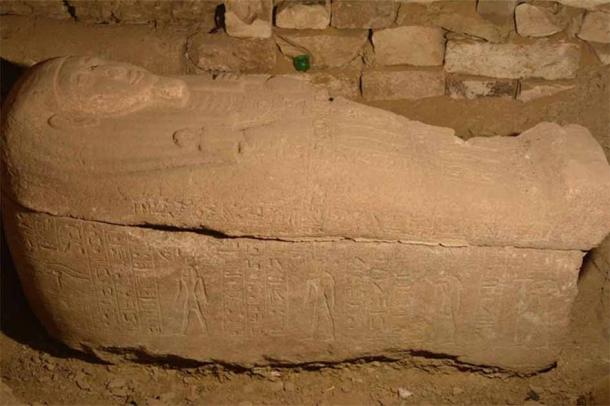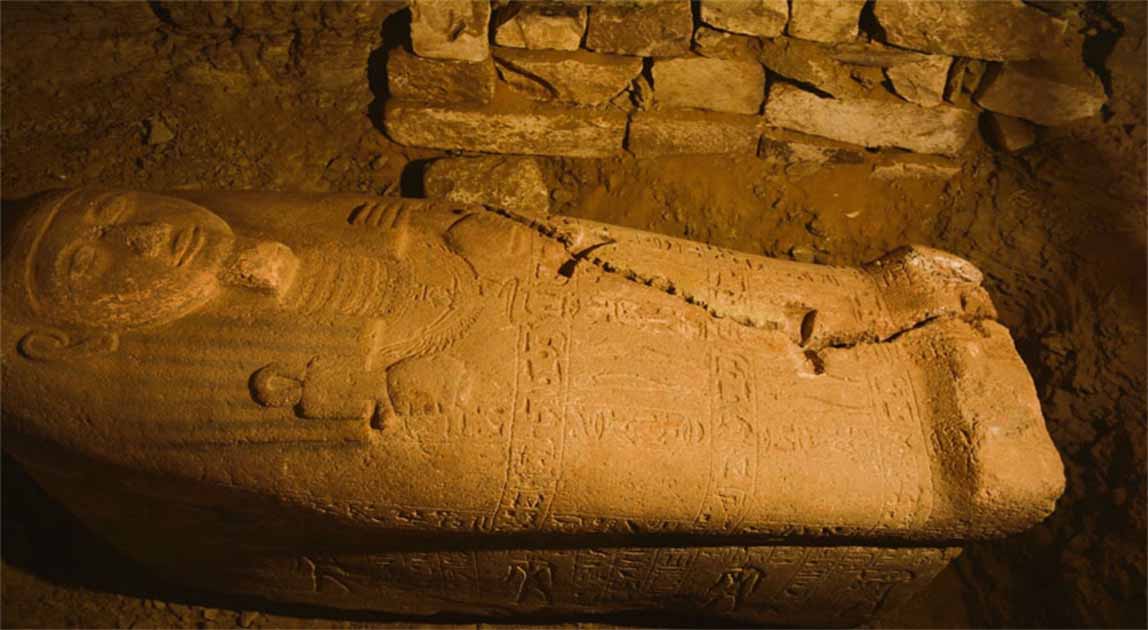Red-Pink Granite Sarcophagus of Ramses II’s Secretary Found at Saqqara
The pink-red granite sarcophagus of Ptahmweia, a royal secretary during the reign of Ramses II (1279-1213 BC) of the Nineteenth Dynasty, has been discovered at the Saqqara necropolis. This is the latest in a series of spectacular discoveries at the Saqqara site, a vast necropolis of the ancient Egyptian capital of Memphis.
This 3,200 year old tomb from the 13th century BC of "a high-ranking official” had the lid of the sarcophagus broken. This was an indication that it had been opened and possibly looted, just like many other tombs and burials in the area, according to Dr. Ola Al-Ajezi, head of the archaeological team, from the Faculty of Archaeology, Cairo University.
The Royal Secretary’s Sarcophagus and a Tricky Tomb Shaft
The sarcophagus was found during the excavations of the mission in the Saqqara Monuments Area, south of the ascending corridor of the King Unas shrine.
The noble was "royal secretary, chief overseer of cattle, head of the treasury of the Ramasseum," Ramses' funerary temple in the Theban necropolis at Luxor, said Mostafa Waziri, head of Egypt's Supreme Council of Antiquities. Royal secretaries were also "responsible for the divine offerings to all the gods of Upper and Lower Egypt," added Waziri in a press release.
- Major Discoveries of Coffins, Burial Shafts and Texts Made in Saqqara
- Burial Statues Add to Death Treasures Unearthed in Saqqara Necropolis
He explained that the entrance to the tomb’s shaft was at the center of a peristyle court that measured 2.2 x 2.1 meters (7.2 x 6.8 feet). This led to the opening of a subterranean burial chamber that opened on the west side of the shaft at a depth of 7 meters (22.96 feet), which led to a square room measuring 4.5 x 4.5 meters (14.7 feet along the perimeter of the square).
This room led to two other rooms on the west and the south sides, which were completely empty. On the north side, a cut in the floor led to stairs that led all the way to the burial chamber (measuring 4.6 x 3.7 meters).

Sarcophagus of Ramses II’s Royal Secretary Discovered in Saqqara. (MOTA)
Examining the Red-Pink Granite Sarcophagus Surface
The Saqqara royal secretary’s sarcophagus had an anthropoid lid depicting the facial features of the deceased, with arms crossed. The crossed arms held the Djed symbol of Osiris and the Tyet symbol of the goddess Isis. This brother-sister duo were married to each other. Osiris’ tragic murder infuriated Isis, and she swore vengeance. She conceived a son with his restored corpse, who was called Horus, another popular Egyptian god.
Scenes representing Horus and his four sons were also found on the sarcophagus lid, along with prayers written in hieroglyphs. These prayers were to “safeguard the deceased” on their journey into the next world. The lid contained the usual inscriptions found on New Kingdom sarcophagi: the bearded head of the owner and the sky-goddess Nut seated on his chest, wings extended.
“The lid of the sarcophagus was broken diagonally, and the missing part was found in the corner of the chamber. It has been restored to its original position. The sarcophagus was empty except for some residue of tar from the mummification on the bottom of the sarcophagus,” said Professor Al-Ajezi to CBS News.
Incidentally, just a day ago, Israeli archaeologists announced a once in a lifetime discovery of a burial cave from the time of Ramses II in a beachside cave in northern Israel, with bronze artifacts and dozens of pottery pieces.
In May, 150 bronze statuettes and 50 wooden sarcophagi dating to the New Kingdom era were found, along with the tomb of Mehtjetju, next to the Step Pyramid of Djoser. Mehtjetju was responsible for guarding the top secret documents of the pharaohs.
- Impressive Tomb of Royal Scribe Unveiled at Saqqara Necropolis
- Elongated Skulls and Indecipherable Language: What Does the Mysterious Starving of Saqqara Sculpture Mean?
Critics have pointed out that sharing the finds of important dignitaries from Egypt’s past is a way of revitalizing and boosting a weak tourism industry. These finds are also being used for the promotion of the Grand Egyptian Museum at the foot of the pyramids, dubbed the "the largest archaeological museum in the world" by local officials. All fascinating stuff really.
Top image: Sarcophagus of Ramses II’s royal secretary discovered in Saqqara, Egypt. Source: MOTA
By Sahir Pandey
References
AFP. 2022. Egypt unveils ancient Rameses II-era ‘royal secretary’ sarcophagus. Available at: https://gulfnews.com/world/mena/egypt-unveils-ancient-rameses-ii-era-royal-secretary-sarcophagus-1.90719200.
El-Aref, N. 2022. Sarcophagus of King Ramses II’s head of treasury unearthed in Saqqara, Giza. Available at: https://english.ahram.org.eg/News/476369.aspx.
Emam, A. 2022. Pink Granite Sarcophagus of Ptahemwia Unearthed in Saqqara. Available at: https://see.news/pink-granite-sarcophagus-of-ptahemwia-unearthed-in-saqqar/.
Heritage Daily. 2022. Archaeologists uncover sarcophagus of high-ranking official from reign of Ramses II. Available at: https://www.heritagedaily.com/2022/09/archaeologists-uncover-sarcophagus-of-high-ranking-official-from-reign-of-rameses-ii/144692.




















Comments
Of course (by their shape), these pieces were designed to be STOOD UP. It remains a mystery what they were intended to store or contain, NOT a recently dead body, but obviously something that would normally be kept in the dark, with lid closed, possibly for preservation. Maybe an assortment of some powerful crystals that people kept, as an common adornment (typically made of wood) to the subterranean living rooms.
Nobody gets paid to tell the truth.